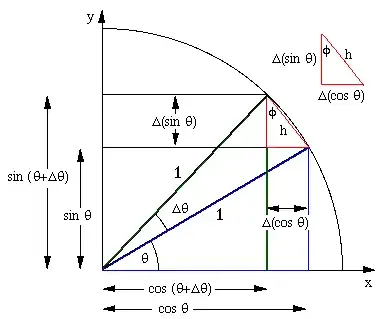I'm following this post https://math.stackexchange.com/a/2169/612996 as my example and I've figured out how it works for $\sin(\theta)$,
During my first try: I keep on missing the factor of $2$ when it's $\sin(2\theta)$. I always get $\cos(2\theta)$
In my work, I've made the angle $2\theta$ and then changed everything that has $\theta$ to $2\theta$, but I've kept the increase in the angle $\Delta\theta$. I think I could reverse-engineer the answer so I use $\Delta 2 \theta$ and get the right answer, but I don't know why that should work and not $\Delta\theta$ since isn't it just a small increase in the angle anyway? (Or is it a small increase that is relative to the angle, and that's why there's a 2?)
During my second try: I understand the algebraic way of doing the chain rule but I want to do it with some sort of geometric intuition.
